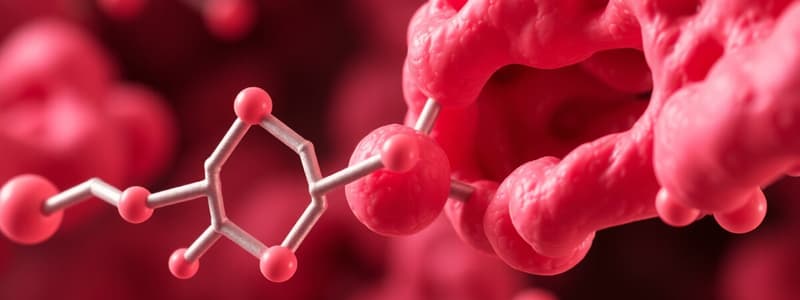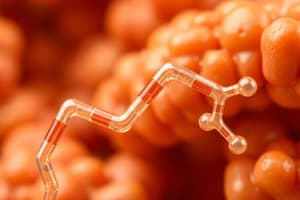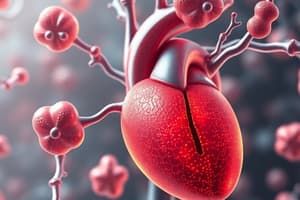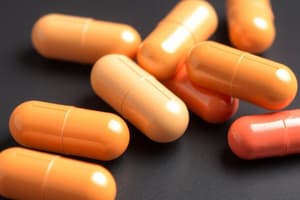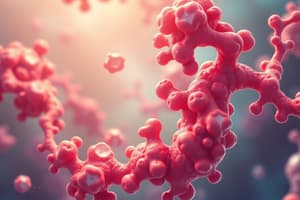Podcast
Questions and Answers
Which enzyme directly regulates the level of free cholesterol in a system by influencing cholesterol esterification?
Which enzyme directly regulates the level of free cholesterol in a system by influencing cholesterol esterification?
- Squalene Monooxygenase
- Oxidosqualene Lanosterol Cyclase
- HMG-CoA Reductase
- Acyl-CoA Cholesterol Acyltransferase (ACAT) (correct)
A protein's amino acid sequence directly determines the sugars added during glycosylation.
A protein's amino acid sequence directly determines the sugars added during glycosylation.
False (B)
What functional group is critical for O-linked glycosylation?
What functional group is critical for O-linked glycosylation?
Hydroxyl
The enzyme regulated to determine whether cholesterol synthesis will take place is ______.
The enzyme regulated to determine whether cholesterol synthesis will take place is ______.
Match the metabolic state with its corresponding hormonal profile:
Match the metabolic state with its corresponding hormonal profile:
In a cell unable to express norepinephrine, which enzyme is most likely deficient?
In a cell unable to express norepinephrine, which enzyme is most likely deficient?
GABA is directly incorporated into proteins, similar to other amino acids.
GABA is directly incorporated into proteins, similar to other amino acids.
During prolonged starvation, what alternative fuel source does the brain utilize to maintain function?
During prolonged starvation, what alternative fuel source does the brain utilize to maintain function?
In the urea cycle, the enzyme ______ catalyzes the conversion of ornithine and carbamoyl phosphate to citrulline.
In the urea cycle, the enzyme ______ catalyzes the conversion of ornithine and carbamoyl phosphate to citrulline.
Match the enzyme with its activation mechanism:
Match the enzyme with its activation mechanism:
Which of the following molecular processes has an inherent editing capability?
Which of the following molecular processes has an inherent editing capability?
Increased cholesterol levels always lead to the formation of gallstones, irrespective of the phospholipid ratio.
Increased cholesterol levels always lead to the formation of gallstones, irrespective of the phospholipid ratio.
Name the two key enzymes most critically regulating pyrimidine synthesis.
Name the two key enzymes most critically regulating pyrimidine synthesis.
In N-linked glycosylation, the main location where this process occurs is the ______.
In N-linked glycosylation, the main location where this process occurs is the ______.
Match the altered metabolic condition with the corresponding disease manifestation:
Match the altered metabolic condition with the corresponding disease manifestation:
Which enzyme is MOST critically involved in incorporating oxygen into squalene, a necessary step for the formation of cyclical lanosterol?
Which enzyme is MOST critically involved in incorporating oxygen into squalene, a necessary step for the formation of cyclical lanosterol?
Increased levels of both squalene substrate and its product regulate the activity of HMG-CoA reductase.
Increased levels of both squalene substrate and its product regulate the activity of HMG-CoA reductase.
Which amino acids are both glucogenic and ketogenic?
Which amino acids are both glucogenic and ketogenic?
During starvation, proteins are broken down for energy, contributing to the production of ______ as a fuel source in the brain.
During starvation, proteins are broken down for energy, contributing to the production of ______ as a fuel source in the brain.
Match each neurotransmitter or precursor with its corresponding description or enzyme:
Match each neurotransmitter or precursor with its corresponding description or enzyme:
Which enzyme’s activity is directly associated with closing the rings to generate the cyclical form of cholesterol from its precursor?
Which enzyme’s activity is directly associated with closing the rings to generate the cyclical form of cholesterol from its precursor?
HMGR is activated when phosphorylated.
HMGR is activated when phosphorylated.
What is the role of glycosyltransferases in N-linked glycosylation?
What is the role of glycosyltransferases in N-linked glycosylation?
The key molecule that does not bioaccumulate in purine biosynthesis is ______.
The key molecule that does not bioaccumulate in purine biosynthesis is ______.
Match the scenario with the likely activity state of HMG-CoA Reductase:
Match the scenario with the likely activity state of HMG-CoA Reductase:
Which enzyme is MOST important for determining the overall rate of cholesterol synthesis?
Which enzyme is MOST important for determining the overall rate of cholesterol synthesis?
The activity of digestive enzymes can be directly evaluated by measuring their concentration in the blood plasma.
The activity of digestive enzymes can be directly evaluated by measuring their concentration in the blood plasma.
If a patient has a history of gallstones related to high cholesterol levels, what dietary change would be most appropriate?
If a patient has a history of gallstones related to high cholesterol levels, what dietary change would be most appropriate?
The enzyme responsible for hydrolyzing peptides bonds adjacent to aromatic amino acids in the stomach is ______.
The enzyme responsible for hydrolyzing peptides bonds adjacent to aromatic amino acids in the stomach is ______.
Match the process with the expected fuel source under each state:
Match the process with the expected fuel source under each state:
Which molecular testing technique provides insight into the functional effect of a genetic mutation on a protein's shape and activity?
Which molecular testing technique provides insight into the functional effect of a genetic mutation on a protein's shape and activity?
During starvation, liver prioritizes regulating ketone body production over maintaining glucose homeostasis for peripheral tissues.
During starvation, liver prioritizes regulating ketone body production over maintaining glucose homeostasis for peripheral tissues.
A patient presents with chronic diarrhea and material in stool that should have been absorbed. Which condition is most likely to cause this?
A patient presents with chronic diarrhea and material in stool that should have been absorbed. Which condition is most likely to cause this?
The genetic mutations and known pathogenic variants are most comprehensively evaluated using the ______.
The genetic mutations and known pathogenic variants are most comprehensively evaluated using the ______.
Match the enzyme with the product of its enzymatic reaction:
Match the enzyme with the product of its enzymatic reaction:
For pregnant women, supplementation with which of the following amino acid groups are recommended even if not normally required?
For pregnant women, supplementation with which of the following amino acid groups are recommended even if not normally required?
A person can directly digest cellulose via the production of appropriate human enzymes.
A person can directly digest cellulose via the production of appropriate human enzymes.
What causes an increase in VLDL and LDL, leading to plague and atherosclerotic lesion?
What causes an increase in VLDL and LDL, leading to plague and atherosclerotic lesion?
In the urea cycle, aspartate mixes into it via the ______ reaction.
In the urea cycle, aspartate mixes into it via the ______ reaction.
Match the enzymes with the location or organ it takes place in.
Match the enzymes with the location or organ it takes place in.
Flashcards
HMG-CoA Reductase
HMG-CoA Reductase
Catalyzes the production of mevalonate from HMG-CoA, a key step in cholesterol synthesis.
Squalene Monooxygenase
Squalene Monooxygenase
Adds oxygen to squalene, necessary for forming the cyclical structure of cholesterol.
Oxidosqualene Lanosterol Cyclase
Oxidosqualene Lanosterol Cyclase
Closes rings to change squalene to cyclical form.
Acyl-CoA Cholesterol Acyltransferase (ACAT)
Acyl-CoA Cholesterol Acyltransferase (ACAT)
Signup and view all the flashcards
HMG-CoA Reductase
HMG-CoA Reductase
Signup and view all the flashcards
Glycosyltransferases (N-linked)
Glycosyltransferases (N-linked)
Signup and view all the flashcards
Variation in Glycosylation
Variation in Glycosylation
Signup and view all the flashcards
Glucosidase Activity
Glucosidase Activity
Signup and view all the flashcards
Functional Group (O-linked)
Functional Group (O-linked)
Signup and view all the flashcards
Amino Acids (Supplement)
Amino Acids (Supplement)
Signup and view all the flashcards
Always Required Amino Acids
Always Required Amino Acids
Signup and view all the flashcards
Ketogenic Amino Acids
Ketogenic Amino Acids
Signup and view all the flashcards
Glucogenic/Ketogenic Amino Acids
Glucogenic/Ketogenic Amino Acids
Signup and view all the flashcards
Protein Degradation Regulation
Protein Degradation Regulation
Signup and view all the flashcards
HMG-CoA Reductase ACTIVE
HMG-CoA Reductase ACTIVE
Signup and view all the flashcards
Purine Synthesis
Purine Synthesis
Signup and view all the flashcards
Pyrimidine Synthesis
Pyrimidine Synthesis
Signup and view all the flashcards
Purine Key Intermediate
Purine Key Intermediate
Signup and view all the flashcards
Pyrimidine Key Intermediate
Pyrimidine Key Intermediate
Signup and view all the flashcards
Molecule NOT Bioaccumulate
Molecule NOT Bioaccumulate
Signup and view all the flashcards
Complex Carbohydrate
Complex Carbohydrate
Signup and view all the flashcards
N-linked Glycosylation
N-linked Glycosylation
Signup and view all the flashcards
O-linked Glycosylation
O-linked Glycosylation
Signup and view all the flashcards
Ability to EDIT genetics
Ability to EDIT genetics
Signup and view all the flashcards
Genome Usefulness
Genome Usefulness
Signup and view all the flashcards
Transcriptome or Exome Usefulness
Transcriptome or Exome Usefulness
Signup and view all the flashcards
Metabolome Usefulness
Metabolome Usefulness
Signup and view all the flashcards
Absent Norepinephrine Expression
Absent Norepinephrine Expression
Signup and view all the flashcards
Trypsinogen Activation
Trypsinogen Activation
Signup and view all the flashcards
Gallstones
Gallstones
Signup and view all the flashcards
VLDL
VLDL
Signup and view all the flashcards
Elevated Blood Ammonia
Elevated Blood Ammonia
Signup and view all the flashcards
Absorption Deficiencies
Absorption Deficiencies
Signup and view all the flashcards
Muscle Breakdown, Starvation
Muscle Breakdown, Starvation
Signup and view all the flashcards
Brain Uses Ketones
Brain Uses Ketones
Signup and view all the flashcards
Study Notes
Block 3 Review Notes
What Enzymes Do
- HMG-CoA Reductase makes mevalonate from HMG-CoA
- Squalene monooxygenase adds oxygen to squalene, which is necessary for cyclical form
- Oxidosqualene lanosterol cyclase closes rings to generate cyclical form
- Acyl-CoA Cholesterol Acyltransferase (ACAT) esterifies cholesterol
- HMGR is the regulator of overall synthesis
- Squalene monooxygenase is regulated by levels of both substrate and product
- ACAT can alter the level of free cholesterol in a system directly because of its role in cholesterol esterification
Cholesterol Synthesis Matching
- HMG-CoA Reductase is the first product, the production of which commits to cholesterol synthesis
- HMG-CoA Reductase is the enzyme regulated to determine whether synthesis will take place
- "March 6 active" is a normal cholesterol level
- "March 6 inactive" is low squalene/high cholesterol
- Mevalonate is high squalene/high cholesterol
- Squalene monooxygenase inactive is high squalene/low cholesterol
- Squalene monooxygenase active is low squalene/low cholesterol
- Cholestasis/Gallstone Production is cholesterol:phospholipid > 1:1
- Cholesterol:phospholipid = 1:1 occurs when there is a normal cholesterol level
Cholesterol Synthesis (Substrate/Metabolic Product) Matching
- Lanosterol is a substrate of synthesis
- Squalene is a substrate of synthesis
- Mevalonate is a substrate of synthesis
- Bile salt is a metabolic product
- Specific steroid hormones are a metabolic product
- Cholesterol Ester is a metabolic product
Glycosylation
- Glycosyltransferases add sugars to the core, determining the final structure of N-glycan chains
- Variation in glycosylation is achieved by enzyme activity during glycosylation such as glycosyltransferases in N-linked glycosylation
- A protein’s amino acid sequence does NOT determine the sugars added, only if they could be glycosylated
- Glucosidase activity utilizes N-linked glycosylation where glucose should be removed if functional
- Hydroxyl functional groups are most likely essential for O-linked glycosylation, using amino acid residues like hydroxylysine, serine, threonine and tyrosine
Amino Acids
- A 36-year-old pregnant woman at 20 weeks should supplement her diet with arginine, cystine, glutamine, glycine, proline, and tyrosine, which are not dietarily required under normal metabolic conditions
- Histidine, isoleucine, leucine, lysine, methionine, phenylalanine, threonine, tryptophan, and valine are always required in the diet
- Isoleucine, leucine, lysine, phenylalanine, threonine, tryptophan, and tyrosine are ketogenic
- Isoleucine, phenylalanine, threonine, tryptophan, and tyrosine are both glucogenic and ketogenic
- Embryogenic determination of muscle mass is responsible for cell turnover and protein turnover
- The need for energy and maintenance of blood glucose contributes to the breakdown of muscle protein during starvation to regulate protein degradation in adults
HMGR Activity (Active/Inactive) Matching
- HMG-CoA Reductase is active when dephosphorylated, when there is more ATP and less AMP, when HMG-CoAR phosphatase is active and when insulin levels are high
- HMG-CoA Reductase is inactive when phosphorylated, when there is a high AMP/ATP ratio, when AMPK is active and when glucagon levels are high
Urea Cycle Pathways
- Urea cycle pathways are the same no matter how they are presented
Purine vs. Pyrimidine Biosynthesis
- Purine synthesis has a high energy cost, adds sugar, then base and has an IMP precursor
- Ribose 5-phosphate, PRPP, GAR, AIR, SACAIR, and AICAR are key intermediates in purine synthesis, which generates AMP and GMP
- Pyrimidine synthesis has a high energy cost, adds base, then sugar and has an UMP precursor
- Carbamoyl phosphate, dihydroorotate and orotate are key intermediates in pyrimidine synthesis, which generates CTP and TMP to TTP
- IMP does not bioaccumulate
- AMP = adenylosuccinate synthetase, CTP = CTP synthetase, GMP = IMP dehydrogenase, TTP = TK1, TYMS, and DTYMK are the most important enzymes in the synthesis of each nucleotide
Glycosylation Key Topics
- Proteoglycans have sugar and some protein
N-Linked Glycosylation
- Main location: ER
- Role of GlcNAc
- Utilizes glycosyltransferases and glycosidases
- Involves asparagine
- Important for mannose and dolichyl phosphate (a membrane bound lipid intermediate)
- Processing in the Golgi is similar to O-linked glycosylation, but overall N-linked glycosylation will not be affected by a lack of sialic acid
O-Linked Glycosylation
- Main location: Golgi
- Role of GalNAc
- Galactosyltransferases are involved
- Uses serine, threonine, hydroxylysine, and tyrosine
- CMP-sialic acid and sialyltransferases are used
Molecular Genetics and Testing Techniques
- DNA polymerase, repair mechanisms, RNA processing, and Aminoacyl tRNA synthetases have the ability to edit
Testing Techniques
- Genome: used for finding genetic mutations and known pathogenic variants by utilizing comparative analysis
- Transcriptome/Exome: used to find genetic expression profiles and tumor molecular profiling for more functional analysis of activity
- Proteome: is used to determine the functional consequences of genetic mutations, can find the functional consequences on protein shape and activity
- Metabolome: used in biochemical analysis of systemic activity for biomarker generation
Neurochemistry
- The inability to express norepinephrine in a cell correlates with the absence or reduced function of dopamine beta-hydroxylase
- Any step in the process could be asked about
- GABA appears to be amino acid-like and derives from amino acids, but it is not incorporated into proteins
Neurotransmitter Matching
- Acetylcholine - Expected only in the fetal neurons and important in pain perception
- Tyrosine - Processed into L-Dopa by tyrosine hydroxylase
- Tryptophan - Precursor of serotonin
- Dopamine - Can be processed into acetate
- Serotonin - Produced by 5-hydroxytryptophan decarboxylase
- Substance P - Produced from L-Dopa by dopamine decarboxylase
Digestion Enzymes
- Pepsinogen is activated by low pH to turn into pepsin, which hydrolyzes peptide bonds adjacent to aromatic amino acids
- Prolipase is activated by binding with colipase to turn into lipase
- Trypsinogen is activated by duodenal enteropeptidase hydrolyzing N-terminal peptide to turn into trypsin, which hydrolyzes peptide bonds adjacent to Arg and Lys
- Chymotrypsinogen is activated by hydrolysis by enteropeptidase or trypsin to turn into chymotrypsin which hydrolyzes peptide bonds adjacent to aromatic amino acids
- Proelastase is activated by hydrolysis by enteropeptidase or trypsin to turn into elastase, which hydrolyzes peptide bonds adjacent to aliphatic amino acids
- Procarboxypeptidase A is activated by hydrolysis by enteropeptidase or trypsin to turn into carboxypeptidase A which hydrolyzes peptide bonds at carboxy terminal amino acids with aromatic or branched aliphatic side chains
- Procarboxypeptidase B is activated by hydrolysis by enteropeptidase or trypsin to turn into carboxypeptidase B, which hydrolyzes peptide bonds at carboxy terminal amino acids with basic side chains
Digestion Enzymes and Functionality
- If an enzyme in digestion isn't functional, there will be reduced digestion and a corresponding inability to absorb that material
- Enzyme activity can be evaluated by what is excreted as well as what is absent from plasma
Metabolic Processes
- Resource availability and hormones determine the metabolic state and timelines for each
Specific Metabolic States
- Absorptive state: fed or during absorbtion of nutrients from ingestion
- Basal: postabsorptive state (short duration)
- Fasting: A few hours post absorptive to approximately 2-3 days
- Starvation: Shift observed at >5 days
Hormone Levels in Each State
- Glucagon levels are higher while fasting and starving
- Insulin levels are higher in absorptive states, but are reduced when post-absorptive states are entered
Processes for Each State
- The main fuel is glucose
- When glucose is scarce, glucose shifts to the brain and RBC
- During starvation, the brain utilizes ketone bodies which are produced by amino acid break down
- A short-term starvation shifts the body to use fats (TAGs and fatty acids from adipose tissue)
- Prolonged starvation then shifts to protein breakdown and ketone body production
Unique Considerations for Tissues Under Each State
- The liver regulates glucose
- Muscles experience protein breakdown in starvation
- The brain will begin using ketone bodies to ensure function
Linking Cause and Effect of Enzymes
- Increased cholesterol leads to gallstones
- Increased cholesterol intake leads to atherosclerosis
- Altered nitrogen metabolism leads to neurological symptoms and problems with the urea cycle
Linking Cause and Effect of Enzymes (Continued)
- Absorption deficiencies lead to short bowel syndrome which results in failure to thrive, vomiting, and chronic diarrhea, or electrolyte imbalance
- Digestion deficiencies / deficiencies in activity of digestive enzymes leads to lactase deficiency where a ptient experiences dietary associated diarrhea and an increase of material in the stool
Studying That Suits You
Use AI to generate personalized quizzes and flashcards to suit your learning preferences.
